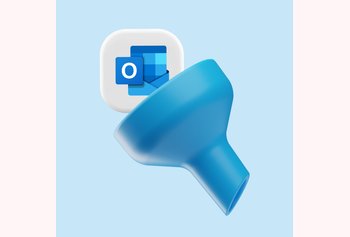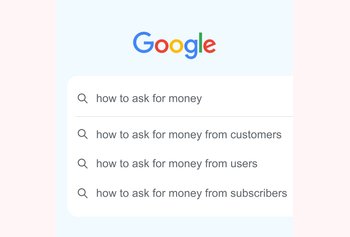15 Best Practices to Write Customer Service Emails
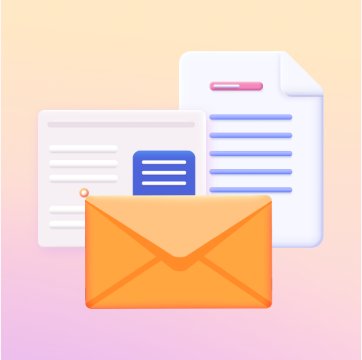
Table of contents
Till date, email remains one of the most important customer service channels. It’s pretty common to see customers email companies their queries and complaints, and these emails being converted into tickets.
But a very important part of handling this communication channel is knowing how to respond to customer service emails.
Email responses that are jargon-heavy or vague can make customers frustrated. You need to empathize with customers and most importantly, know how to account for non-verbal communication cues.
Good customer service emails are easy to understand, and help customers achieve what they’re looking for. In this post, we’ll share tips and templates for writing such emails. You can also try our free AI email writer to draft clear and professional emails for your customers.
Table of Contents
- What are Customer Service Emails?
- Importance of Great Customer Service Emails
- 15 Best Practices of Customer Service Emails
- 1. Be Human
- 2. Use FAQ Articles in Emails
- 3. Personalize Emails
- 4. Apologize When Necessary
- 5. Avoid Imperatives
- 6. Keep It Simple
- 7. Specify proper time frames for resolutions
- 8. Use proper styling and formatting to make emails easy to read
- 9. Know When to Upsell
- 10. Follow-up Proactively
- 11. Avoid using too much jargon
- 12. Offer prompt responses
- 13. Use email templates
- 14. Use ticket management
- 15. Offer alternatives in cases where customer expectations are not feasible
- Examples of Companies Doing their Customer Service Emails Right
- Way Forward
What are Customer Service Emails?
Customer service emails are written responses from a company to a customer’s inquiry, complaint, or request, aiming to resolve issues or provide information. These communications are a key part of maintaining good customer relationships by offering support and solutions through email.
Importance of Great Customer Service Emails
It’s vital to understand email etiquette for customer support. Great customer service emails are important for several key reasons.
- Customer Satisfaction: Well-crafted emails can resolve issues efficiently, leading to higher customer satisfaction and loyalty. Utilizing customer service software can further enhance the quality and speed of email responses.
- Brand Reputation: Such emails reflect the company’s commitment to quality service, influencing the public perception and reputation of the brand.
- Customer Retention: By addressing concerns and providing a positive experience, great emails encourage customers to continue doing business with the company.
- Issue Resolution: Effective email communication helps in resolving problems quickly, reducing the likelihood of escalation and further complications.
- Cost-Effective Support: Email support is often more cost-effective compared to phone or in-person support, allowing for detailed, documented responses that can be managed efficiently.
- Building Relationships: Personalized, thoughtful responses help build stronger relationships with customers and drive higher engagement.
Did You Know: 72% of customers switch brands after just one negative experience.
15 Best Practices of Customer Service Emails
A well-written customer service email can help you build stronger relationships with customers and make every interaction effective and empathetic. It can help you improve the quality of your service and impact customer perception and loyalty.
Here are some best practices to follow for sending effective customer service emails.
1. Be Human
One of the biggest tips to keep in mind when writing a customer service email is to make sure that the message looks as if it is coming from an actual person.
However, with automation in customer service on the rise, this is not always the case.
Customers often receive robotic-sounding auto-responders to their queries and it can dehumanize the entire experience for them.
Here’s an example of such an email:
“Hi,
We have just received your request. We will get back to you within 2 business days. For the record, your support ticket number is ABC235. Please present it for all future correspondence.
Thanks,
The Support Team.”
The problem with such an email is that it makes the customer feel like they are just another number in a long queue of waiting customers. It lacks a personal touch and what’s worse is that the email may come across as cold and indifferent to an already upset and frustrated customer.
To avoid this, we’d suggest you consider the following tips when framing your responses:
- Use a friendly and empathetic tone to show the customer that you genuinely understand their frustration.
- Talk about what you’re trying to do to fix the problem.
- Specify a time frame within which they can expect a response.
- Try to use your name – not just the company’s name. It makes you look more human.
- Keep the email light-hearted. Try to add an emoji here and there to put your customer at ease.
Keeping these tips in mind, here’s a better response to a customer query as compared to the previous one.
Hey Nathan,
I am really sorry you had to spend time figuring this out. I understand this must be frustrating for you.
I’ve relayed this to our product team already. Allow me to get back to you in 2 to 3 hours.
Cheers, June
2. Use FAQ Articles in Emails
Some customer queries can be efficiently resolved through self-service options like knowledge bases or FAQs. These resources empower customers to find solutions independently, without waiting for a response from support teams.
However, when a customer makes the effort to reach out to you via email, it it implies one of these things:
- The customer couldn’t find the answer they were looking for or they aren’t aware you have a self-help section
- The answer found the answer on your knowledge base but it wasn’t sufficient.
In such cases, it’s important to assess the nature of the customer query and respond accordingly.
While it’s practical to guide customers towards self-help resources for common and straightforward issues, the way you do this matters significantly. Instead of bluntly directing them to a help page, a more tactful approach involves addressing their query directly in the email, then gently guiding them to additional resources for more information or future reference.
Here’s how you can write the email:
Subject: Assistance with Your [Specific Issue] Inquiry
Dear [Customer Name],
Thank you for reaching out to us about [specific issue]. We understand how [briefly acknowledge the customer’s feelings or situation related to the issue].
To address your current concern, [provide a clear, step-by-step solution or answer to the specific question]. For more detailed instructions or related topics, you might find our [specific section/article] in our Knowledge Base helpful: [Insert Link]. This resource is designed to provide immediate assistance and comprehensive guidance.
If you have tried the above solution and are still facing difficulties, or if you have any further questions, please don’t hesitate to contact us. We’re here to ensure you have the best experience with [Product/Service Name].
Thank you for your patience and understanding. We appreciate the opportunity to assist you.
Warm regards,
[Your Name]
[Company Name]
3. Personalize Emails
Personalization is a non-negotiable for great customer service. It focuses on making customers feel seen, heard, and valued as individuals rather than just another ticket number. In fact, about 77% of customers will choose, recommend, or pay more for a brand that provides personalized service.
So what does personalization in customer service emails look like?
- Start your emails with a friendly greeting and use the customer’s first name to establish a personal connection.
- Mention any previous interactions (if any) to show the customer that you’re familiar with their history with your company and that you understand the issue at hand.
- Offer details on the next steps or solutions. For instance, if you’re sending an email about a refund, specify the amount that will be refunded and the last four digits of the account or credit card to which it will be credited. You can even offer a discount in case there was an error on your end like delayed shipping or missing items.
- Include personalized recommendations to add value.
- Send a quick follow-up a few days after the problem has been resolved to check-in with the customer and see if they are satisfied with your service.
Here’s an example of such a personalized customer service email:
Subject: We’ve Got a Special Update for You, John!
Dear John,
I hope this email finds you well! I noticed that you recently had an issue with your last order of the XYZ product. I’m really sorry about the inconvenience it caused. I’ve looked into your order history and see that you prefer [specific product feature or type], so I’ve included a special coupon for your next purchase of any similar product.
We’ve also taken steps to ensure your future orders go smoothly. If there’s anything specific you’d like us to keep in mind for your orders, please let us know. Your feedback is invaluable to us.
If you have any more questions or need further assistance, don’t hesitate to reach out. I’m here to help!
Best regards,
[Your Name]
[Your Contact Information]
4. Apologize When Necessary
Acknowledging that your business has made a mistake and taking responsibility for it is a critical component of customer service. It shows empathy, accountability, and a commitment to resolving the issue. Here’s how to effectively incorporate apologies into your customer service communications:
- Acknowledge Customer Feelings: Start by recognizing the customer’s distress. This demonstrates empathy and understanding, which can help defuse frustration. Here’s an example: “I understand how upsetting this must be for you, and I’m truly sorry for any inconvenience caused.”
- Take Responsibility: If your company is at fault, clearly acknowledge it. Avoid making excuses or deflecting blame, as this can further aggravate the situation. Example: “We take full responsibility for [specific issue]. It’s not the experience we aim to provide, and we are genuinely sorry for the oversight.”
- Use Empathetic Language: Phrases that convey understanding and empathy can be very effective in calming an upset customer and building a connection. You can always say: “I completely understand why you’re upset. This isn’t what we want our customers to go through, and I am sorry that it has been your experience.”
- Provide Assurance: Assure the customer that you are taking steps to prevent the issue from recurring. This shows commitment to service improvement. Example: “We are actively working to ensure this doesn’t happen again. Here are the steps we’re taking: [briefly outline actions].”
- Offer a Solution: After apologizing, immediately offer a way to make things right. Be clear about how you intend to resolve the issue. Use words like: “To make up for this, we would like to [offer a solution or compensation]. We hope this helps to address the inconvenience you’ve experienced.”
By incorporating these practices into your apology emails, you can turn a negative situation into a positive one, potentially restoring the customer’s faith in your company and preventing future issues.
Here’s a sample apology email:
Subject: Our Apologies for [Issue] – Your Experience Matters to Us
Dear [Customer Name],
I am truly sorry to hear about [specific issue, e.g., your delayed order]. I understand how frustrating and inconvenient this must have been for you, and I cannot apologize enough for the distress it has caused.
We take full responsibility for [the specific issue]. It was a mistake on our part, and not the level of service we strive to provide. Please accept our sincerest apologies. We have identified the problem and are taking the following steps to ensure it doesn’t happen again: [briefly outline the actions being taken].
To make it right, we would like to [offer a specific solution or compensation, e.g., a refund, replacement, or discount on future purchases]. We hope this will help to alleviate some of the inconvenience you’ve experienced.
Your satisfaction is our priority, and we are committed to making sure this error doesn’t recur. If you have any further concerns or require additional assistance, please don’t hesitate to contact me directly at [contact information].
Best regards,
[Your Name]
[Company Name]
5. Avoid Imperatives
If you are not sure what imperatives are, they are words that sound like instructions or commands — “do this” or “do that”.
Here is where you can go wrong: “Go to the dashboard and press on the gear icon that you see on the top right”
You’d rather say: “Could you please head to the dashboard and click on the gear icon that you see in the top right corner?”
See the difference? The second response is more polite and friendly, putting the reader at ease.
Apart from imperatives, here are a few negative phrases to avoid:
- “You claim that”
- “You must”
- “You should”
These words are bound to make your customers feel uncomfortable or put forth your business as one that’s rude.
Instead, you might want to use the below phrases in your emails to give a positive spin to your message:
- “You’d want to”
- “May we suggest”
- “We can assist you with (the task) if you could please send us (the information).”
When you begin to use positive and encouraging words, you start to see a difference in the way customers respond to you.
119 Email Phrases to Help You Get the Desired Response
6. Keep It Simple
If your customer service emails look like instruction manuals, they are definitely not making life easy for customers.
Before you set out to write an email to a customer, keep in mind that they are looking for quick and easy resolutions. Think about how your email is going to help them and frame your message so that it is easy to read and understand.
Here are a few tips to write simple yet contextual customer service emails:
- Incorporate clean and simple images into your emails to create a visually engaging experience for your customer. Often images work better than text at making instructions clear and easy to follow.
- Use bullet points or numbers instead of writing long paragraphs.
- Guide your customers on all the pre-checks before plunging into the solution. It can be something as insignificant as checking if they have the right browser— but you would still want to start with that.
- Ask yourself the following questions as well:
- Does the customer have to follow a particular sequence?
- Does the customer have to check or do something before they get to the core of the problem?
- Are there more ways than one to start solving a problem? If so which would be the best way for the customer to solve the problem?
Take a look at this sample email:
Hey Ashley,
I am sorry you had difficulty setting up the autoresponder – here’s how you can do it:
Before that: Make sure you are not using Gmail’s native autoresponder as there might be a conflict.
-Go to the Hiver Admin panel
-Click on the Shared Mailbox tab to see the list of Shared Mailboxes on your Hiver account
-Click on the ‘gear’ icon on the extreme right of the Shared Mailbox on which you want to do the setup
-Choose the ‘Autoresponder’ option and fill up the details.
-Click on ‘Save’
P.S. Please feel free to let me know if you’d like me to set this up for you. Happy to help!
7. Specify proper time frames for resolutions
When a customer reaches out for help, they are often looking for a quick and reassuring response. Using vague phrases like “as soon as we can” may leave them uncertain about whether you have a solution or how long it will take.
Instead, it’s essential to be clear and precise in your communication. Acknowledge the issue directly, provide a specific timeframe or steps you are taking to resolve it, and offer a clear point of contact for further questions.
In customer service, it’s important to create positive experiences for your customers. Each message should reverberate with confidence and positivity. You want your customers to know they are in safe hands. So let them know that you have a plan and a solution to offer.
Go back to the customer with a clear time frame on when they can expect an answer. Something along these lines:
Subject: Resolution Plan for Your [Specific Issue/Query]
Dear [Customer Name],
Thank you for reaching out to us about [specific issue/query]. We understand how important it is for you to have this resolved quickly and we are here to ensure a smooth and efficient solution.
We have reviewed your request and are currently [brief explanation of the steps being taken or investigation process]. We expect to have this resolved for you by [specific timeframe, e.g., “end of the next business day” or “within 48 hours”].
In the meantime, if you have any more questions or need additional assistance, please don’t hesitate to reach out. You can contact us directly at [Contact Information] or reply to this email. [If applicable, include names or contact details of specific personnel handling the issue].
We appreciate your patience and want to assure you that we are doing everything possible to rectify this situation promptly. Thank you for choosing [Company Name], and we are committed to providing you with the quality service you deserve.
Best regards,[Your Name]
[Company Name]
8. Use proper styling and formatting to make emails easy to read
Some customer service emails may include more than one question from a customer. Clubbing your responses for all of these questions into one long paragraph makes your email clunky and unreadable. Consider using the sentence rewriter to simplify and break down your responses. This ensures each answer is clear and concise, making it easier for the customer to understand.
If your email is overwhelming, customers may skip reading the email entirely. This can negatively impact customer satisfaction since the email you sent is unhelpful in helping the customer resolve their query.
Instead, here are a few things you can do to make your emails easier to read:
- Divide your responses into multiple sections to answer the different questions raised by the customer.
- If you can, use bold formatting to create subheadings for sections.
- Use italics to emphasize a point. For further simplification, tools like HTML email hyperlinks can also help streamline email communication by guiding customers to pre-filled responses and reducing confusion.
Take a cue from this sample email:
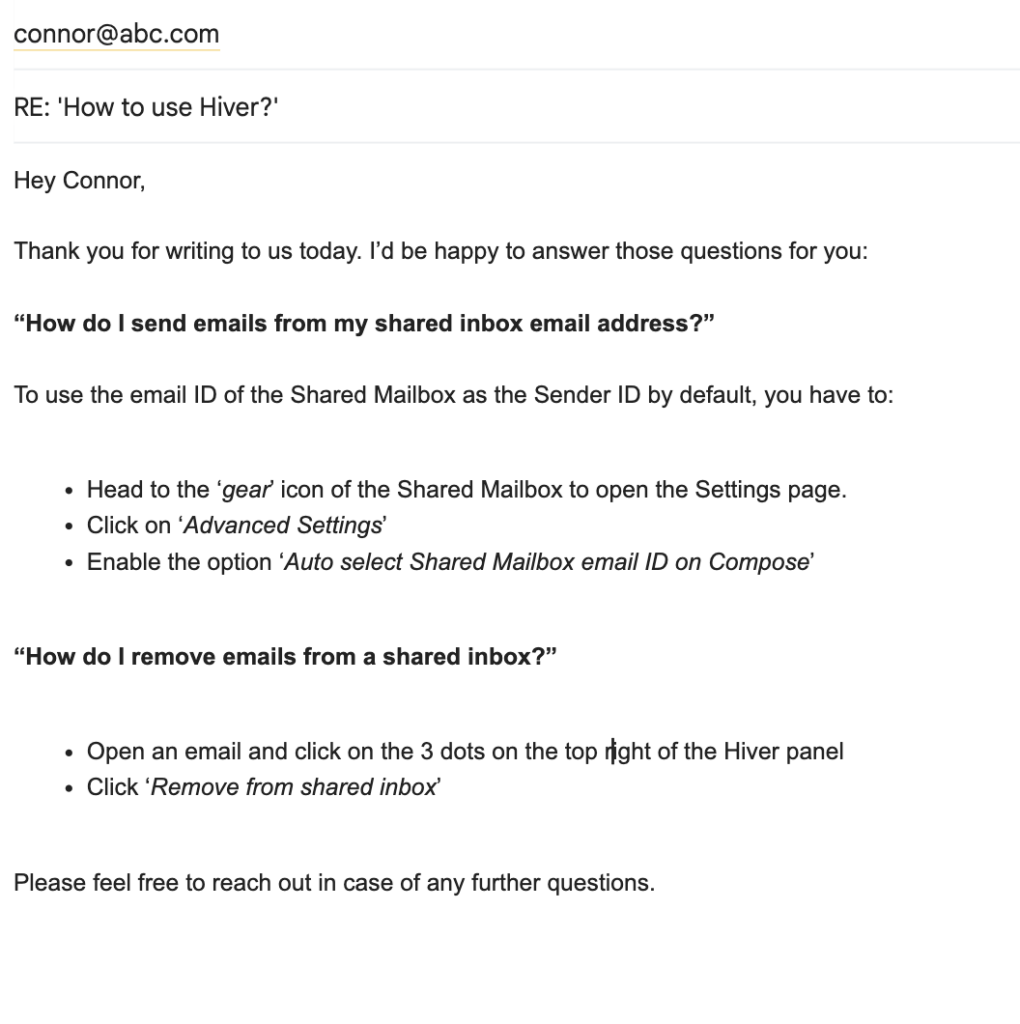
9. Know When to Upsell
It’s a whole lot easier to sell to an existing customer than it is to a new customer. According to research, the chances of converting an existing customer is 60-70%, however, the chances of converting a new lead into a customer are only 5 to 20%.
These numbers say it all. People respond better to brands and companies they are familiar with.
Keeping this in mind, you would not want to forgo the opportunity to nudge customers to a sale in your customer support emails, but you have to tread carefully.
Remember these golden rules:
- Never try to upsell without solving a customer problem.
- Never try to upsell to an angry customer. It could easily backfire.
- Inserting a product page link early in a customer service email can distract the customer from the issue at hand. It’s more effective to address their immediate concern first and include any additional links or resources at the end of the communication.
10. Follow-up Proactively
Excellent customer service doesn’t end with the first email that you send out. It also includes follow-ups.
Unless the customer has vehemently stated that they do not want to hear from you again, you should send a follow-up email to check in on them. See if they have been successful in solving the problem or if they have any further questions for you.
Send a follow-up email after a reasonable amount of time has passed since the initial resolution. The appropriate time may vary depending on the issue but generally, 24-48 hours allows customers to assess if the solution is working.
Remind them that you’re there to help further if needed. This reinforces your commitment to their satisfaction.
You can write something like this:
“I hope this message finds you well. I’m just checking in to see how everything is going after our recent correspondence about [issue]. Have you noticed any improvements?
If you’re still experiencing issues or have any questions, please don’t hesitate to reach out. We’re here to ensure everything is working smoothly for you.”
While follow-up is important, keep the email brief and to the point to respect the customer’s time. In some cases, you can also use the opportunity to ask for feedback. This not only shows that you value their opinion but also helps you improve quality of service.
11. Avoid using too much jargon
A lot of times, you may see customer service emails that are jargon-heavy with technical or industry-specific terms. This is a big no-no.
Remember that your customers are the end users of your product or service. They aren’t familiar with the technical lingo and using jargon can frustrate your customers and make information really hard to understand.
Instead, use clear and concise language so that your message is understood by customers irrespective of their expertise. When customers grasp the information provided, they are much more likely to resolve issues quickly, which reduces the burden on your support team.
Here are some tips to write clear, simple emails:
- Assume right from the beginning that your customers are likely people who are not too familiar with technical jargon. So, instead of saying something like ‘the API integration failed’, you can just say ‘there was an issue in connecting our service to [name of the application].’
- Replace complex terms with simpler alternatives – use instead of utilize, feature instead of functionality, time/capacity instead of bandwidth, install instead of implementation
- Explain the technical complexity behind an issue as simply as you can. For instance, ‘Our API (a tool that allows two applications to communicate) is currently down, and we are working to resolve the issue.’
- Include an option for a customer to reach out to you if they have further questions or did not understand your point.
12. Offer prompt responses
No one likes to be kept waiting after they have emailed you about an issue they are facing. Now, if you are not able to provide a solution right away, ensure that you acknowledge the email. Let customers know you’ve received their complaint and assure them you are working towards finding a resolution as quickly as possible.
A timely response or acknowledgement shows customers that you understand the severity of their issue and demonstrates your reliability. Timely intervention is also important in preventing customer issues from escalating into bigger problems.
The best way to ensure your support team responds to every customer email without delay is to set up service level agreements or SLAs. These are formal agreements that specify the level of service a business should offer its customers to meet their expectations consistently.
Hiver allows you to configure SLAs for every incoming email. For instance, every customer email should receive a response within the first two hours of receiving the email. In cases where this is violated, an ‘SLA violation tag’ is added to the email and stakeholders are notified immediately. This allows you to track and manage customer emails effectively.
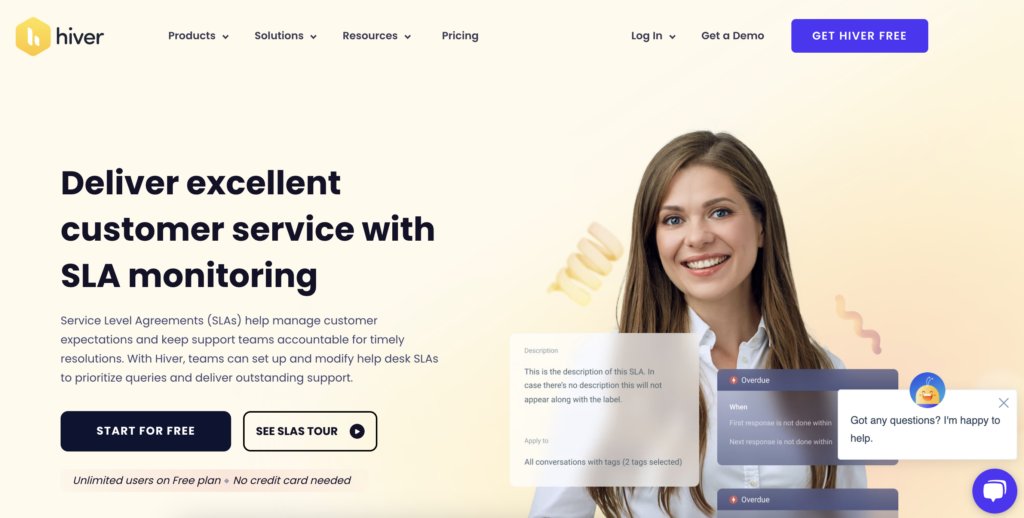
13. Use email templates
Like we said before, quick responses demonstrate professionalism and improve customer satisfaction.
However, framing a response for every email can be cumbersome, especially if most of them require pretty much the same, standardized responses.
In such situations, the best way to respond faster is to use email templates. Simply create email responses for common business inquiries using Hiver’s email templates and share them with your team. Use auto-fill variables to personalize the email templates and attach images, videos, or PDFs in sections where you need to add more context.
This saves your team from repetitive work and allows them to acknowledge and respond to incoming emails faster.
14. Use ticket management
If your support team deals with a huge volume of customer emails every day, we’d recommend using a ticket management system. This gives you a systematic way to track and prioritize incoming messages so every email receives an accurate and timely response and nothing falls through the cracks.
For instance, a tool like Hiver allows you to manage customer emails from the comfort of your inbox. You can convert every email into a ticket and use automation to assign them to the appropriate agents based on their skill or workload. For instance, any email with the term ‘refunds’ in the subject line or message body can be automatically routed to the billing and accounts department.
Use Notes present alongside every email to tag your team members and work collaboratively with colleagues on email inquiries.

You can even monitor the progress of an email by tracking its status and seeing whether it is ‘Open’, ‘Closed’, or ‘Pending’.
15. Offer alternatives in cases where customer expectations are not feasible
There are some rare occasions where you may not be able to offer the exact resolution expected by a customer. Some common scenarios include product unavailability, refunds for certain products, missed deadlines, policy concerns, or scheduling conflicts.
In such cases, make sure that you:
- Express your genuine apology in not being able to fulfill the customer’s request. Give a clear and concise explanation of why the particular solution is not feasible.
- Present the alternatives clearly and explain the benefits of each option.
- Keep your tone supportive and empathetic.
- Remain open to discussing other potential solutions with the customer to reach a mutually beneficial resolution.
Here’s a sample email offering an alternative solution to a refund request made by a customer:
Subject: Alternative Solutions for Your Refund Request
Dear [Customer Name]
Thank you for reaching out to us regarding your recent purchase of [Product/Service Name]. I truly appreciate your business and the opportunity to assist you.
I understand that you’ve requested a refund for your order. After reviewing your request, I regret to inform you that, unfortunately, we are unable to process a refund due to our policy, which states that [briefly explain the relevant policy, e.g., “refunds cannot be issued for digital products once they have been downloaded”].
However, I completely understand your concerns and want to ensure that you have a positive experience with us. With that in mind, I’d like to offer you the following alternatives:
Store Credit: We can issue you a store credit of equal value to your purchase, which you can use at any time on any product or service in our catalog. This credit never expires, giving you the flexibility to make a future purchase when it suits you.
Discount on Future Purchase: As a goodwill gesture, I can offer you a 20% discount on your next order with us. This discount can be applied to any product or service and will be valid for the next six months.
We hope one of these options will be suitable for you. Please let me know which option you would prefer, or if you have any other suggestions in mind. Our goal is to make sure you are satisfied with your experience, and I’m here to assist you in any way I can.
Thank you for your understanding, and I look forward to hearing from you soon.
Best regards
[Your Name]
[Your Position]
[Your Company Name]
Examples of Companies Doing their Customer Service Emails Right
Here are some interesting examples of companies doing their customer service emails well.
1. Zappos
Zappos is known for their legendary customer service and has showcased their unsurpassable efforts on multiple occasions.
In one such occasion, Zappos decided to pleasantly surprise one of their customers by upgrading the shipping time on one of their orders as a way of appreciating their business.

2. Amazon
Amazon is one of the largest e-commerce platforms in the market and their customer service is quick, effective, and consistently customer-centric.
Their customer-centric approach reflects in how they offer resolutions to their customers. For example, an Amazon Prime user placed an order, expecting the one-day delivery perk of Prime membership. However, the delivery was delayed and to compensate, Amazon extended the customer’s prime membership by a whole month!

3. Buffer
Buffer is a social media toolkit that helps small businesses seamlessly manage their social media marketing campaigns.
The platform offers a free trial and any time you sign up for one, you get a prompt email from Buffer’s support team. The email highlights how the user can get the most out of the tool and encourages them to reach out to Buffer’s 24/7 customer service team for any help.
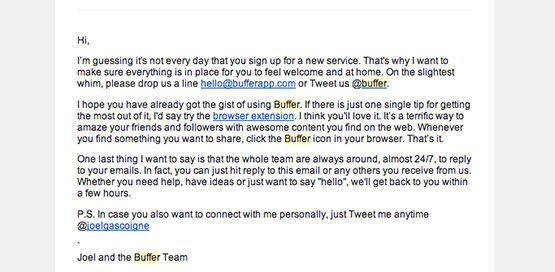
Way Forward
In customer service, a lot of interactions happen over email. Perfecting the art of email writing can set you on the right track to enhancing customer satisfaction, and turning new customers into loyalists.
By following the best practices that we have laid out here, your customer service team will be better equipped to craft meaningful and effective emails that earn you happy customers. Also, if you’re looking to hire customer service professionals to help increase customer satisfaction and loyalty, you can use Adaface’s customer service test to screen and identify top candidates.
If you’re looking for a customer service solution that can help you create compelling customer service emails, check out Hiver. The tool inside Gmail helps to improve the quality of your customer service emails and enables you to resolve customer issues faster than you think.
Get started with Hiver today. Free for 7 days.












